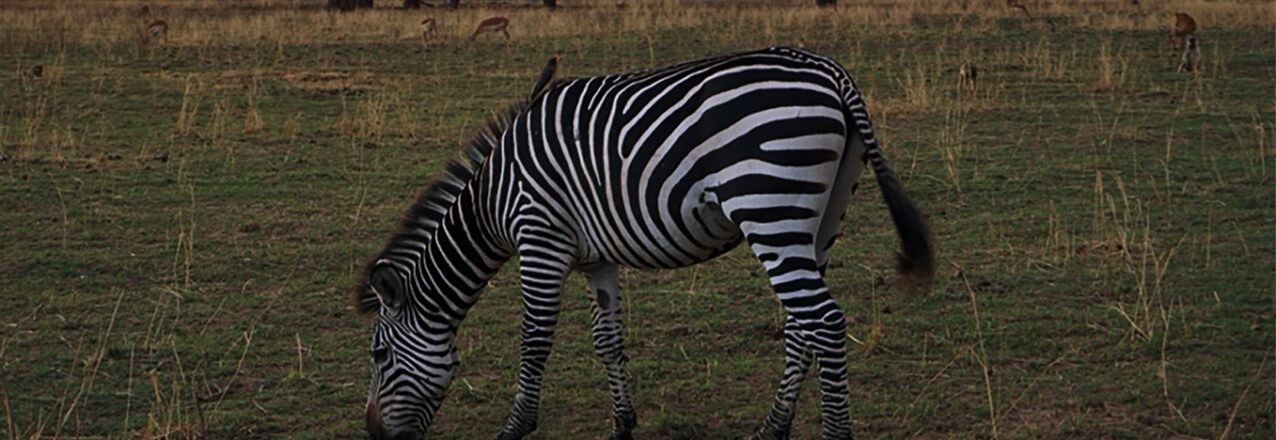Photo: A zebra grazes within the South Luangwa National Park in eastern Zambia. For many local communities, wildlife tourism provides for livelihoods and a further need to properly manage natural resources. Source: Rita Singer for USAID
Bupe Banda was the Zambia Community Resource Board Association’s (ZCRBA) first employee when it was created with USAID support in 2016. With a background in environmental education, she also once interned with the Department of National Parks and Wildlife in Zambia and saw firsthand the challenges of allocating conservation-targeted resources to rural communities living within game management areas and national parks.
In Zambia, half of all safari hunting fees in game management areas (GMA) are shared with the community where the hunt takes place. The funds are then overseen by the local Community Resources Board (CRB) and used to support education, health, and rural development initiatives. Hunting fees also pay the salaries of community scouts who patrol the GMAs for poaching and encourage sustainable utilization of wildlife, forests, and fisheries.
Late last year, when a large share of 2018/19 hunting fees worth more than 19 million Zambian kwacha (equivalent to US$2 million at the time) were still unpaid by the government, Bupe and her colleagues went to the halls of power to demand answers. ZCRBA convened a handful of chiefs—the customary leaders of these lands—to meet with the Minister of Tourism and make it clear that if the fees were not paid, they would no longer allow hunting in their chiefdoms.
“We face a real challenge to move money from the government accounts to community resource boards. The CRBs need a collective voice, a strong and legitimate voice that speaks for the community,” Bupe explains.
The outstanding fees were finally paid to CRBs in February 2020. This outcome is what Bupe calls “advocacy with development.”
ZCRBA is just the voice these community organizations need. The association acts as an umbrella for 76 CRBs, as well as Zambia’s emerging community forest groups and fisheries groups. For these communities with CRBs, wildlife tourism revenue is their biggest earner, so the incentives to properly manage natural resources are high. Having Bupe and ZCRBA as advocates brings peace of mind to hundreds of families who rely on wildlife for livelihoods.
Quality of Leadership
Bupe, who is now the National Administrator of the association, and her colleague Isaac Banda, the ZCRBA National Coordinator and a member of the Mkhanya CRB, have since participated in leadership training with the Africa Conservation Leadership Network. The workshops are funded by USAID in partnership with The Nature Conservancy, and have helped Bupe to recognize her skills and overcome her fear of public speaking.
Focused leadership training has also allowed her to learn practical planning tools like meeting management, fundraising, and team building. “Now, I feel like I represent the association wherever I go.”
The leadership trainings form part of USAID’s capacity-building efforts for civil society conservation groups that lack the organizational capacity and confidence to achieve effective advocacy, influence, and community development. Stronger leadership skills are expected to help close the gap created by the isolation and general lack of infrastructure facing CRBs when it comes to scaling their impact in conservation. Although these community groups are often led by passionate individuals, they are missing a critical mass.
USAID is providing CRBs with additional tools and skills to achieve a more cohesive network of wildlife advocates. In 2020, with USAID support, ZCRBA is rolling out smart phones to CRB leaders as well as organizational and planning tools. Phone connectivity will allow the association to better serve the needs of the CRBs, while improving their chances for coordinated action and fundraising.
Finally, USAID is trying to challenge and transform gender norms within the CRBs by offering gender leadership training to increase women’s participation. When not completely absent, women’s representation in CRBs leadership is very low. Of the 76 CRBs in Zambia, 72 are led by men, and the few women who participate experience challenges in the male-dominated structures.
Women leaders like Bupe are rare in Zambia’s conservation sector; however by working with individuals and institutions at a national level, USAID is paving the pathway to ensure there will be more Bupes in the next generation of leaders.


